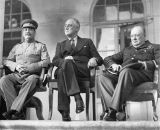Leadership Theories
For decades, leadership theories have been the source of numerous studies. In reality as well as in practice, many have tried to define what allows authentic leaders to stand apart from the mass! Hence, there as many theories on leadership as there are philosophers, researchers and professors that have studied and ultimately published their leadership theory. A great article to read before diving into the theories is the The Philosophical Foundations of Leadership
Theories are commonly categorized by which aspect is believed to define the leader the most. The most widespread one's are: Great Man Theory, Trait Theory, Behavioural Theories, Contingency Theories, Transactional Theories and Transformational Theories.
leadership Theories
Great Man Theory (1840s)

The Great Man theory evolved around the mid 19th century. Even though no one was able to identify with any scientific certainty, which human characteristic or combination of, were responsible for identifying great leaders. Everyone recognized that just as the name suggests; only a man could have the characteristic (s) of a great leader.
The Great Man theory assumes that the traits of leadership are intrinsic. That simply means that great leaders are born...
they are not made. This theory sees great leaders as those who are destined by birth to become a leader. Furthermore, the belief was that great leaders will rise when confronted with the appropriate situation. The theory was popularized by Thomas Carlyle, a writer and teacher. Just like him, the Great Man theory was inspired by the study of influential heroes. In his book "On Heroes, Hero-Worship, and the Heroic in History", he compared a wide array of heroes.In 1860, Herbert Spencer, an English philosopher disputed the great man theory by affirming that these heroes are simply the product of their times and their actions the results of social conditions.
Trait Theory (1930's - 1940's)
The trait leadership theory believes that people are either born or are made with certain qualities that will make them excel in leadership roles. That is, certain qualities such as intelligence, sense of responsibility, creativity and other values puts anyone in the shoes of a good leader. In fact, Gordon Allport, an American psychologist,"...identified almost 18,000 English personality-relevant terms" (Matthews, Deary & Whiteman, 2003, p. 3).
The trait theory of leadership focused on analyzing mental, physical and social characteristic in order to gain more understanding of what is the characteristic or the combination of characteristics that are common among leaders.
There were many shortfalls with the trait leadership theory. However, from a psychology of personalities approach, Gordon Allport's studies are among the first ones and have brought, for the study of leadership, the behavioural approach.
- In the 1930s the field of Psychometrics was in its early years.
- Personality traits measurement weren't reliable across studies.
- Study samples were of low level managers
- Explanations weren't offered as to the relation between each characteristic and its impact on leadership.
- The context of the leader wasn't considered.
Many studies have analyzed the traits among existing leaders in the hope of uncovering those responsible for ones leadership abilities! In vain, the only characteristics that were identified among these individuals were those that were slightly taller and slightly more intelligent!
Behavioural Theories (1940's - 1950's)
In reaction to the trait leadership theory, the behavioural theories are offering a new perspective, one that focuses on the behaviours of the leaders as opposed to their mental, physical or social characteristics. Thus, with the evolutions in psychometrics, notably the factor analysis, researchers were able to measure the cause an effects relationship of specific human behaviours from leaders. From this point forward anyone with the right conditioning could have access to the once before elite club of naturally gifted leaders. In other words, leaders are made not born.
The behavioural theories first divided leaders in two categories. Those that were concerned with the tasks and those concerned with the people. Throughout the literature these are referred to as different names, but the essence are identical.
Associated Theories
Contingency Theories (1960's)
The Contingency Leadership theory argues that there is no single way of leading and that every leadership style should be based on certain situations, which signifies that there are certain people who perform at the maximum level in certain places; but at minimal performance when taken out of their element.
To a certain extent contingency leadership theories are an extension of the trait theory, in the sense that human traits are related to the situation in which the leaders exercise their leadership. It is generally accepted within the contingency theories that leader are more likely to express their leadership when they feel that their followers will be responsive.
Associated Theories
- Fiedler's contingency theory
- Hersey-Blanchard Situational Leadership Theory
- Path-goal theory
- Vroom-Yetton-Jago decision-making model of leadership
- Cognitive Resource Theory
- Strategic Contingencies Theory
Transactional leadership Theories (1970's)
Transactional theories, also known as exchange theories of leadership, are characterized by a transaction made between the leader and the followers. In fact, the theory values a positive and mutually beneficial relationship.

For the transactional theories to be effective and as a result have motivational value, the leader must find a means to align to adequately reward (or punish) his follower, for performing leader-assigned task. In other words, transactional leaders are most efficient when they develop a mutual reinforcing environment, for which the individual and the organizational goals are in sync.
The transactional theorists state that humans in general are seeking to maximize pleasurable experiences and to diminish un-pleasurable experiences. Thus, we are more likely to associate ourselves with individuals that add to our strengths.
Associated Theories
Transformational Leadership Theories (1970s)

The Transformational Leadership theory states that this process is by which a person interacts with others and is able to create a solid relationship that results in a high percentage of trust, that will later result in an increase of motivation, both intrinsic and extrinsic, in both leaders and followers.
The essence of transformational theories is that leaders transform their followers through their inspirational nature and charismatic personalities. Rules and regulations are flexible, guided by group norms. These attributes provide a sense of belonging for the followers as they can easily identify with the leader and its purpose.
Associated Theories
- Burns Transformational Leadership Theory
- Bass Transformational Leadership Theory
- Kouzes and Posner's Leadership Participation Inventory
Stay Informed!!
Get our Newsletter.


New! Comments
Have your say about what you just read! Leave me a comment in the box below.